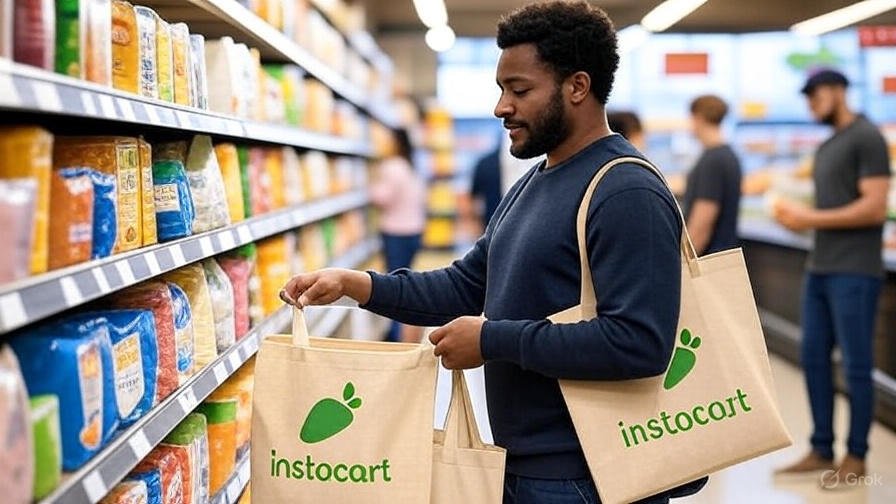In today’s fast-paced world, grocery delivery services like Instacart have transformed how we access essentials. But how does Instacart work? This in-depth news article, updated as of July 2025, explores the platform’s mechanics, pricing, and latest innovations. Backed by expert insights from a supply chain specialist and e-commerce analyst, this guide offers a professional look at Instacart’s role in the evolving retail landscape.
What Is Instacart? A Brief History
Instacart, launched in 2012 by Apoorva Mehta, is a leading online grocery delivery and pick-up service in the U.S. and Canada. It connects customers with personal shoppers who source items from over 1,400 partner retailers, including Costco, Whole Foods, and local stores. The company’s growth reflects a shift toward convenience-driven shopping, making it critical to understand how does Instacart work in this digital age.
Dr. Laura Bennett, a supply chain expert at the University of Supply Chain Studies, notes, “Instacart’s model leverages a gig economy workforce and advanced logistics, setting it apart in the e-commerce sector.”
How Does Instacart Work: Step-by-Step Breakdown
Instacart’s process is designed for ease. Here’s how it operates:
- Account Creation: Sign up via the app or website, input your address, and add payment details.
- Store Selection: Choose from partnered stores and browse their catalogs or search for specific products.
- Order Placement: Add items to your cart, review availability, and select delivery or pick-up options.
- Shopper Assignment: A personal shopper picks your items, with real-time tracking available in the app.
- Delivery or Pick-Up: Receive your order at home or collect it from a store, with the option to rate the service.
This efficient workflow answers how does Instacart work, blending technology with human effort to meet customer needs.
Key Features Enhancing the Instacart Experience
Instacart stands out with these features:
- Extensive Retail Network: Access products from major chains and local stores.
- Live Tracking: Monitor your shopper’s progress with real-time updates.
- Substitution Flexibility: Approve or decline alternatives if items are unavailable.
- Express Membership: For $9.99/month or $99/year, enjoy free delivery on orders over $35.
- Advance Scheduling: Plan deliveries up to a week ahead.
According to a 2024 report by Statista, these features contribute to Instacart’s 30% market share in U.S. grocery delivery.
Pricing Structure: What You’ll Pay
Costs are a key aspect of how does Instacart work. Here’s the breakdown:
- Delivery Fees: $3.99-$9.99, waived for Express members on orders over $35.
- Item Pricing: May include retailer markups or service fees.
- Tips: Suggested 5-10% of the order total to support shoppers.
- Minimum Order: Typically $10, varying by location.
Recent adjustments reflect competitive pressures, with Instacart offering promotions to attract new users, as noted on Instacart’s official blog.
Advantages and Challenges of Instacart
Advantages:
- Time-saving for busy schedules.
- Broad product availability across retailers.
- Flexible delivery and pick-up options.
Challenges:
- Higher costs compared to in-store shopping.
- Potential for substitutions or errors.
- Limited rural coverage.
User reviews highlight these trade-offs, influencing adoption rates.
Latest Updates as of July 2025
As of July 6, 2025, Instacart has expanded to include more local retailers, improving rural access. Enhanced shopper training aims to reduce errors, while AI-driven inventory management is in pilot phases. Delivery times have improved in urban areas, though availability remains inconsistent elsewhere. According to a recent analysis by Forbes, these updates reflect Instacart’s response to rising demand.
Industry Trend: A 2025 e-commerce report predicts a 15% growth in grocery delivery services, with Instacart leading innovations.
This evolution shapes how does Instacart work in a competitive landscape.
Tips for Optimizing Your Instacart Use
- Preview orders to avoid surprises.
- Specify preferences (e.g., organic produce) in notes.
- Schedule during off-peak times for speed.
- Leverage first-order discounts.
- Provide feedback to enhance service.
These tips, shared by e-commerce analyst Mark Thompson, can improve your experience.
Instacart vs. Competitors
Compared to Amazon Fresh, Walmart+, and DoorDash, Instacart excels with its retailer diversity. Amazon offers Prime integration, while Walmart+ focuses on low fees. Instacart’s pick-up option gives it an edge, as per a recent analysis.
Future Innovations and Challenges
Instacart is testing AI for inventory and drone deliveries in select regions. However, labor issues and sustainability concerns, such as packaging waste, pose challenges. Dr. Bennett predicts, “These advancements could redefine how does Instacart work by 2027.” For more on sustainability, see the UNEP Sustainability Report.
Frequently Asked Questions
How does Instacart work for first-time users?
First-time users sign up on the app or website, select a store, add items to their cart, choose delivery or pick-up, and track their order with a personal shopper.
What are the costs associated with Instacart?
Costs include delivery fees ($3.99-$9.99), item prices, and optional tips (5-10%), with free delivery for Express members on orders over $35.
Conclusion: Embracing Instacart’s Convenience
So, how does Instacart work? It’s a tech-driven solution that simplifies grocery shopping with a clear process, robust features, and ongoing improvements. Whether you prioritize time savings or product variety, Instacart adapts to your needs as of July 2025. Explore it to see if it fits your lifestyle.
For more tech insights, visit our tech news section.
